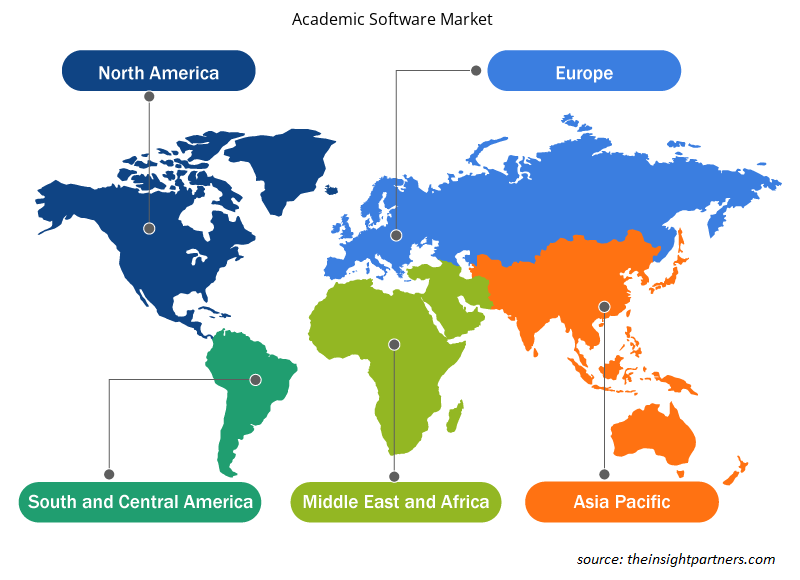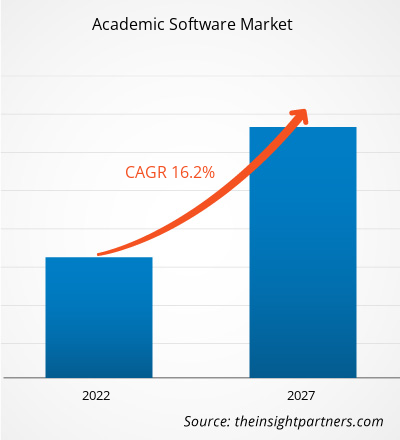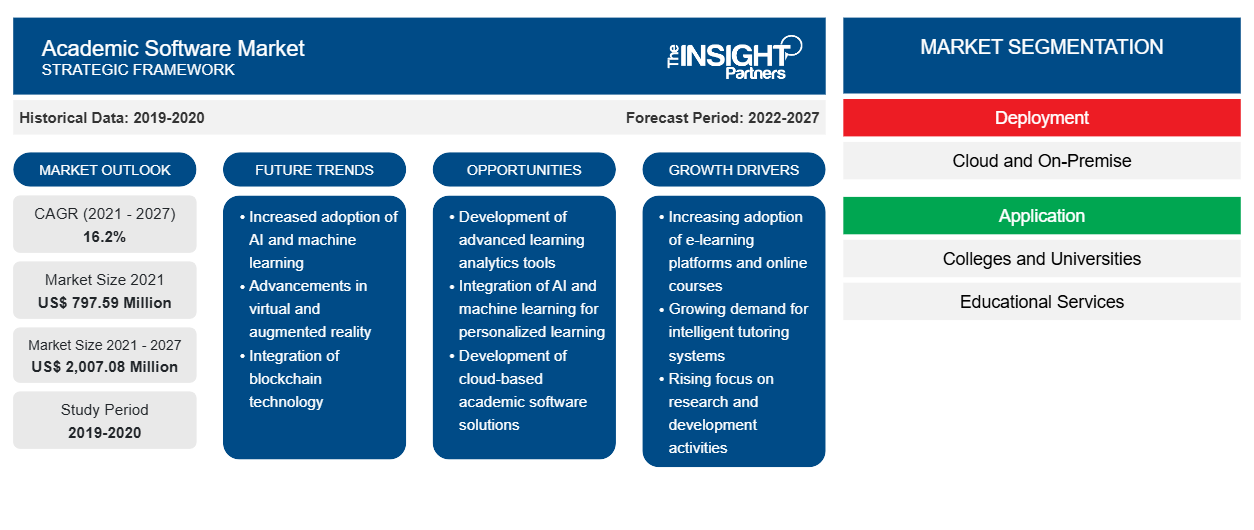Si prevede che il mercato del software accademico crescerà da 797,59 milioni di dollari nel 2021 a 2.007,08 milioni di dollari entro il 2027. Si prevede che il mercato del software accademico crescerà a un CAGR del 16,2% durante il periodo di previsione dal 2021 al 2027.
L'adozione crescente dell'eLearning tra le istituzioni è il fattore chiave che guida la crescita del mercato del software accademico. Nell'eLearning, leggendo o guardando contenuti, si sta cambiando il modo in cui viene erogata l'istruzione. Diversi corsi di eLearning come animazioni, podcast e video creano un ambiente di apprendimento multimodale e realistico. L'eLearning, i contenuti educativi aprono diverse opportunità di apprendimento immersivo per gli studenti tramite computer, laptop, tablet o smartphone. Invece di trovarsi in un ambiente passivo, gli studenti possono scegliere ciò di cui hanno bisogno per imparare facilmente e rapidamente. Questi vantaggi stanno aumentando la domanda di software accademico in tutto il mondo.
La pandemia di COVID-19 ha gravemente colpito il settore dell'istruzione in tutto il mondo. Ciò ha anche promosso l'adozione di un sistema di istruzione online in tutte le principali economie del mondo; influenzando così l'adozione di software per varie applicazioni, come la fornitura di lezioni, la gestione degli studenti e altre attività operative da postazioni remote. Pertanto, si prevede che la crescente adozione di soluzioni tecnologicamente avanzate in tutto il settore avrà un impatto positivo sulla crescita del mercato del software accademico durante la pandemia.
In base all'implementazione, il mercato del software accademico è segmentato in cloud e on-premise. Nel 2019, il segmento cloud ha rappresentato una quota maggiore nel mercato. Negli ultimi anni, il settore tecnologico ha assistito a un aumento costante dell'adozione del cloud computing. Ciò è dovuto al fatto che il cloud computing semplifica i tempi di implementazione e riduce sostanzialmente i costi di implementazione. Questo vantaggio ha attratto un gran numero di utenti finali; pertanto, la maggior parte degli operatori del mercato del software accademico fornisce prodotti basati su cloud insieme alla crescente domanda di software basati su cloud. Inoltre, l'infrastruttura Internet nei paesi sviluppati si è evoluta e sta fiorendo in molti paesi in via di sviluppo, consentendo agli utenti finali di accedere alle soluzioni basate su cloud sia nei paesi sviluppati che in quelli in via di sviluppo.
Personalizza questo report in base alle tue esigenze
Riceverai la personalizzazione gratuita di qualsiasi report, comprese parti di questo report, o analisi a livello nazionale, pacchetto dati Excel, oltre a usufruire di grandi offerte e sconti per start-up e università
-
Scopri le principali tendenze di mercato in questo rapporto.Questo campione GRATUITO includerà analisi di dati che spaziano dalle tendenze di mercato alle stime e alle previsioni.
Approfondimenti sul mercato del software accademico
Integrazione di tecnologie come l'intelligenza artificiale con soluzioni software accademiche
L'intelligenza artificiale (IA) è una tecnologia che fornisce ai computer la capacità, allo stesso modo degli esseri umani, di comunicare con le persone, comprendere gli eventi e apprendere e reagire agli eventi. Nel corso degli anni, l'intelligenza artificiale non solo ha avuto enormi applicazioni in vari settori, come la sicurezza, la sorveglianza e la tecnologia informatica, ma ha anche registrato un aumento nell'adozione delle tecnologie nel settore dell'istruzione. L'IA viene adottata in scuole, college e università per automatizzare attività ripetitive, come la valutazione, l'analisi finanziaria e i processi di ammissione. Ad esempio, l'IA può essere calibrata per apprendere e modellare le azioni degli insegnanti durante la valutazione, tramite programmi per computer avanzati, come la valutazione automatica, per l'assegnazione automatica dei voti in futuro. Nel tempo, il programma apprenderà le competenze accademiche di più studenti e, in base alle loro prestazioni, preparerà piani di formazione personalizzati.
Approfondimenti di mercato basati sulla distribuzione
In base al tipo di distribuzione, il mercato globale del software accademico è segmentato in cloud e on-premise. Il software accademico basato su cloud sta assistendo a una domanda elevata rispetto al software accademico on-premise. Il segmento cloud genera la maggior parte della domanda poiché è relativamente meno costoso grazie alla solida infrastruttura di rete nei paesi sviluppati. Inoltre, i fornitori di software accademico basati su cloud sono altamente concentrati sullo sviluppo di una patch di sicurezza di alto livello per eliminare il rischio di attacchi informatici. Questo fattore sta anche creando una domanda significativa da parte degli utenti finali, guidando così il mercato del software accademico.
Approfondimenti di mercato basati sulle applicazioni
In base all'applicazione, il mercato del software accademico è segmentato in college e università, servizi educativi e altri. La crescente adozione di soluzioni moderne in istituti scolastici e università per offrire corsi sia online che offline agli studenti, insieme all'iniziativa di rendere disponibili soluzioni avanzate a tutto il personale e agli studenti, sta influenzando l'adozione del software accademico. Ciò sta alimentando la crescita del mercato nel corso degli anni.
I player che operano nel mercato del software accademico si concentrano su strategie, come iniziative di mercato, acquisizioni e lanci di prodotti, per mantenere le loro posizioni nel mercato del software accademico. Ecco alcuni sviluppi dei player chiave del mercato del software accademico:
A dicembre 2020, la piattaforma del sistema informativo per studenti Alma ha introdotto la funzionalità delle medie dei voti (GPA) che è stata aggiunta allo strumento del registro dei voti. La valutazione basata sugli standard (SBG) è radicata nell'allineamento del feedback degli studenti e della misurazione dei progressi rispetto alle competenze specifiche insegnate e valutate, piuttosto che utilizzare un singolo punteggio per coprire più argomenti o standard.
A luglio 2020, ConexED ha aggiornato la sua app iOS 2.2.3 per un'esperienza più intuitiva. Questa app consente a studenti, personale e docenti di partecipare a riunioni virtuali e videoconferenze sui loro dispositivi mobili.
Approfondimenti regionali sul mercato del software accademico
Le tendenze regionali e i fattori che influenzano il mercato del software accademico durante il periodo di previsione sono stati ampiamente spiegati dagli analisti di Insight Partners. Questa sezione discute anche i segmenti e la geografia del mercato del software accademico in Nord America, Europa, Asia Pacifico, Medio Oriente e Africa e America meridionale e centrale.

- Ottieni i dati specifici regionali per il mercato del software accademico
Ambito del rapporto sul mercato del software accademico
| Attributo del report | Dettagli |
|---|---|
| Dimensioni del mercato nel 2021 | 797,59 milioni di dollari USA |
| Dimensioni del mercato entro il 2027 | 2.007,08 milioni di dollari USA |
| CAGR globale (2021 - 2027) | 16,2% |
| Dati storici | 2019-2020 |
| Periodo di previsione | 2022-2027 |
| Segmenti coperti |
Per distribuzione
|
| Regioni e Paesi coperti |
America del Nord
|
| Leader di mercato e profili aziendali chiave |
|
Densità dei player del mercato del software accademico: comprendere il suo impatto sulle dinamiche aziendali
Il mercato del software accademico sta crescendo rapidamente, spinto dalla crescente domanda degli utenti finali dovuta a fattori quali l'evoluzione delle preferenze dei consumatori, i progressi tecnologici e una maggiore consapevolezza dei vantaggi del prodotto. Con l'aumento della domanda, le aziende stanno ampliando le loro offerte, innovando per soddisfare le esigenze dei consumatori e capitalizzando sulle tendenze emergenti, il che alimenta ulteriormente la crescita del mercato.
La densità degli operatori di mercato si riferisce alla distribuzione di aziende o società che operano in un particolare mercato o settore. Indica quanti concorrenti (operatori di mercato) sono presenti in un dato spazio di mercato in relazione alle sue dimensioni o al valore di mercato totale.
Le principali aziende che operano nel mercato del software accademico sono:
- Alma
- SOFTWARE PER CAMPUS CAFÉ
- ConexED
- Soluzioni Envisio Inc.
- TESSUTO COMPLETO
Disclaimer : le aziende elencate sopra non sono classificate secondo un ordine particolare.

- Ottieni una panoramica dei principali attori del mercato del software accademico
Mercato del software accademico – per distribuzione
- Nuvola
- In sede
Mercato del software accademico – per applicazione
- College e università
- Servizi educativi
- Altri
Mercato del software accademico – per area geografica
-
America del Nord
- NOI
- Canada
- Messico
-
Europa
- Francia
- Germania
- Russia
- Regno Unito
- Italia
- Resto d'Europa
-
Asia Pacifico (APAC)
- Cina
- India
- Giappone
- Australia
- Corea del Sud
- Resto dell'APAC
-
MEA
- Arabia Saudita
- Emirati Arabi Uniti
- Sudafrica
- Resto del MEA
-
SAM
- Brasile
- Argentina
- Resto del SAM
Mercato del software accademico – Profili aziendali
- Alma
- SOFTWARE PER CAMPUS CAFÉ
- ConexED
- Soluzioni Envisio Inc.
- TESSUTO COMPLETO
- PowerVista Software, Inc.
- Qualtrics LLC
- Società Tophatmonocle
- Vero dialogo
- Alveare magico
- Analisi storica (2 anni), anno base, previsione (7 anni) con CAGR
- Analisi PEST e SWOT
- Valore/volume delle dimensioni del mercato - Globale, Regionale, Nazionale
- Industria e panorama competitivo
- Set di dati Excel
Report recenti
Rapporti correlati
Testimonianze
Motivo dell'acquisto
- Processo decisionale informato
- Comprensione delle dinamiche di mercato
- Analisi competitiva
- Analisi dei clienti
- Previsioni di mercato
- Mitigazione del rischio
- Pianificazione strategica
- Giustificazione degli investimenti
- Identificazione dei mercati emergenti
- Miglioramento delle strategie di marketing
- Aumento dell'efficienza operativa
- Allineamento alle tendenze normative























 Ottieni un campione gratuito per - Mercato del software accademico
Ottieni un campione gratuito per - Mercato del software accademico